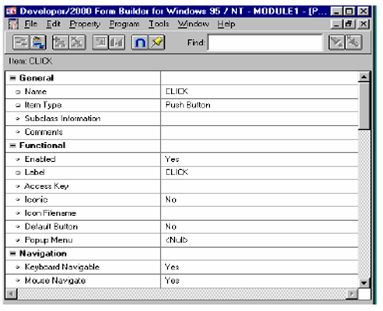Property Class
Within visual attributes defining a visual attribute object and relating visual attributes objects to the items on the form. In this chapter we learn about assigning property class to other objects on the form.
Property class inheritance is powerful feature which permits you to quickly define objects which conform to your own interface and functionality standards. The Property classes also permits you to make global modifications to applications quickly. Through simply changing the definition of a property class, you can modify the definition of all objects in which inherit properties from that class. The property class is a named object which contains a list of properties and their settings. One time you create a property class you can base other objects on it.
For instance, you may describe separate property classes for enterable items, needed items, required items, and read-only items. When you need to modify the appearance and functionality of all such items in an application, you required only update the properties in the property class.
There can be any number of properties in a property class and the properties in a class can apply to variant types of objects. For instance, a property class may hold some properties which are general to all types of items, some that apply only to text times and some which apply only to check boxes.
Property classes are divided objects, and as such, can be copied among modules as required. Possibly more importantly, property classes could be referenced in any number of modules.
Each object in a form module, as well as the form module itself, has properties which dictate the object’s behavior. Whenever an object is first created, it is automatically assigned various property values by default. You can modify by default. You could change these property values in the Property Palette.
